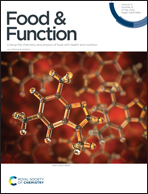Konjac oligosaccharides attenuate DSS-induced ulcerative colitis in mice: mechanistic insights†
Abstract
This study aims to explore the protective effect of konjac oligosaccharides (KOS) on inflammatory bowel disease in colitis mice. During the experimental period, mice were administered 200 mg kg−1 or 600 mg kg−1 KOS, 200 mg kg−1 sulfasalazine and a combination of KOS and sulfasalazine for 14 days. The mice were then treated with drinking water containing 2.5% DSS for 9 days, while the intervention of KOS and sulfasalazine continued. At the end of the experiment, the phenotype, pathological lesion of the colon, parameters of cytokines and gut microbiota were evaluated. The results showed that mice treated with KOS exhibited alleviated pathological lesion of the colon tissue and significantly increased expression of tight junction proteins (p < 0.05). The level of inflammatory cytokines in the colon tissue of the colitis mice tended to be normal. Moreover, the analysis of the gut microbiota revealed that the structures and composition of the intestinal microorganisms were also regulated by KOS treatment. The possible internal mechanism is that KOS down-regulates the abundance of pro-inflammatory bacteria (Proteobacteria, Campilobacterota and Clostridiaceae) and up-regulates the abundance of anti-inflammatory bacteria (Bifidobacteriaceae and Akkermansiaceae). These findings provide new insights into dietary management for patients with inflammatory bowel disease.



 Please wait while we load your content...
Please wait while we load your content...